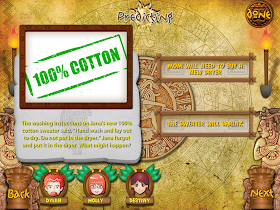Language Winner was voted the 3rd best educational app of 2011 by AppsForHomeschooling.com and the 9th best educational app of 2011 by SmartAppsForKids.com!
According to the app description, Language Builder is designed to help children accomplish the following educational goals: 1) Improve sentence ideation ; 2) Improve sentence formation; and 3) Improve receptive and expressive language.
Let's take a look, shall we?
Info:
As with all Mobile Education Store apps, there is an "info" tab along the bottom. Tapping this tab will bring you to a brief synopsis of the purpose of the app as well as how to use the app.
Settings:
From the settings screen, you can set up/add/change a student profile. You can choose to have the "hint button" enabled or disabled, turn on/off audio instructions, change the level of hints, and select image themes. You can also watch the Video Tutorial for more information.
The Available Image Themes include:
- Original Game Pack
- Inside Playtime Game Pack
- Places Game Pack
- Winter Game Pack
- Pets Game Pack
- Sports Game Pack
- School Game Pack
- Water Game Pack
- Hobbies Game Pack
- Medical Game Pack
- Playground Game Pack
You also have the option of randomly selecting from all of the themes.
From the settings screen, you can select one of three different hint options: Hint Level 1, Hint Level 2, and Hint Level 3. We'll see more about these in a minute.
Play:
You will be shown a picture and prompted by a voice recording to "make a sentence about the picture." There will be three buttons - "Record," "Hint," or "Skip Picture." As you can probably guess, tap "Record" to record the child's response. "Skip picture" will move you along to the next picture. (All the levels begin the same way...the hints are the what changes.)
Hint Level 1
Tapping "Hint" on Level 1 will give you a fill-in-the-blank sentence with two blanks:
Hint Level 2
This time you are shown just the beginning of a sentence and the student must complete the rest.
Hint Level 3
On this level, when you tap "Hint," you will be given two words to use in the sentence. For this example, you are told to "Use the words 'big' and 'sky' in your sentence."
Notice that you can record your students' responses? Once you record, you can play it immediately and/or save the recording for future analysis.
When you save the recording, you are prompted to give it a name.
Archive:
The last tab along the bottom of the screen is "Archive." This is where you can see the recordings that you saved.
Tap on a saved sentence and you will be able to play the saved sentence, delete the sentence, or share the sentence. Tapping "Share Sentence" will attach the image and audio clip to an email, which you can send to yourself, teachers, and/or parents:
In case you want to see some more samples of the target images:
And that's Language Builder in a nutshell! Here are my thoughts:
The Pros:
- Real-life photos. The photos are great for depicting action. Students will be able to relate to many of the images as well.
- Simple, yet effective. This app is simple to use, but can be used to target many different objectives - sentence formulation, pronoun use, present progressive verb tense, articulation carry-over, monitoring voice and fluency strategies, etc.
- Recording feature. What student doesn't love to hear their own voice? This can be motivating for some of our kiddos who would not complete this type of task in a flash-card format.
- Archive feature. This is a great feature when you want to keep pre/post test data. I also love that you can email the recordings to yourself so that you are not taking up too much space on your iPad.
- Ability to add multiple players.
- The different hint levels allow for scaffolding with students. From any given picture (before you record), you can change the hint levels to provide more/less support as needed.
- No multi-player option. I don't know about you, but most of my sessions consist of groups of students. You could come up with a profile of "Language Group" and save recordings with the child's name.
- There is no audio for hint levels 1 and 2. Not a major con, but most of the students on my caseload cannot yet read, so I need to read the hints to them.
The Bottom Line:
Language Builder is yet another quality app from Mobile Education Store! Language Builder is great for targeting sentence formulation, but can also be used for a variety of other objectives. You could also use this app with a variety of age ranges. I love apps that are versatile and Language Builder is definitely one of those apps!
Could you use Language Builder in your practice? Kyle was gracious enough to provide a copy for me to give away. You can enter using the Rafflecopter below.
Disclaimer: Although Kyle from Mobile Education Store was kind enough to provide me with a copy of Language Builder to review and another to give away, the opinions expressed in this review are mine alone.

























































